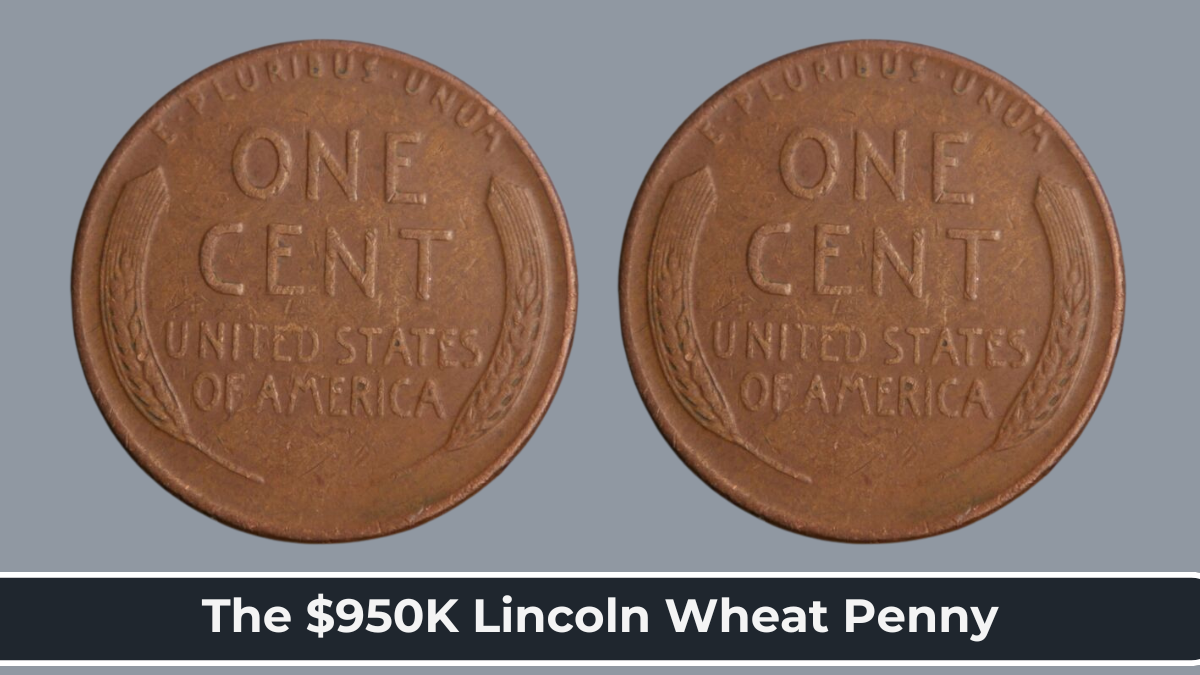The next time you receive change, take a closer look at those pennies—you might be holding a small fortune. Some rare Lincoln Wheat Pennies have fetched nearly $950,000, making them one of the most valuable one-cent coins in history. Despite their rarity, a few of these prized coins still circulate, passing unnoticed through countless hands.
The History Behind the Lincoln Wheat Penny
The Lincoln Wheat Penny was first minted in 1909 to celebrate the 100th anniversary of Abraham Lincoln’s birth. Designed by Victor David Brenner, it was the first U.S. coin to feature a real historical figure, replacing the traditional Lady Liberty.
The reverse side showcased two wheat stalks, symbolizing America’s agricultural prosperity. This design remained in production until 1958, when it was replaced by the Lincoln Memorial Penny.
What Makes a Lincoln Wheat Penny So Valuable?
While most Wheat Pennies hold only modest value, certain rare variations are worth hundreds of thousands—even millions—of dollars. Their high value comes from several factors:
- Minting Errors – Some coins contain mistakes, such as doubled designs or incorrect materials.
- Limited Mintage – Pennies produced in small numbers at specific mint locations are rarer.
- Condition & Rarity – The fewer coins that exist in high-quality condition, the more valuable they become.
The 1943 Copper Penny: A $1.7 Million Mistake
The most valuable Lincoln Wheat Penny is the 1943 Copper Penny, with some specimens selling for over $1.7 million.
During World War II, the U.S. Mint switched from copper to zinc-coated steel to conserve copper for military supplies. However, a few copper planchets (blank coins) from 1942 accidentally remained in the presses, producing one of the rarest pennies ever made.
Why Is the 1943 Copper Penny So Valuable?
- Only about 30 authenticated coins exist.
- A genuine specimen sold for $840,000 in 2021, with others surpassing $1.7 million in auctions.
- Fake 1943 Copper Pennies exist—a real one will not stick to a magnet (unlike steel pennies from that year).
Other Highly Valuable Wheat Pennies
Several other Lincoln Wheat Pennies are also worth a fortune.
| Coin | Estimated Value | Notable Feature |
|---|---|---|
| 1909-S VDB | Up to $100,000 | Designer’s initials (“VDB”) on the reverse. |
| 1914-D | Up to $150,000 | Rare Denver Mint production. |
| 1922 “No D” | Up to $90,000 | Denver Mint error—missing mint mark. |
| 1931-S | Up to $75,000 | Low mintage, only 866,000 produced. |
| 1955 Doubled Die | Up to $125,000 | Double-struck design makes letters appear doubled. |
How to Spot a Valuable Wheat Penny
If you suspect you have a valuable Lincoln Wheat Penny, check for these features:
- Check the Date – Look for key years like 1909-S, 1914-D, 1922 “No D”, and 1943 Copper.
- Look for Mint Marks – The mint mark appears below the date. Coins from San Francisco (S) and Denver (D) tend to be rarer than those from Philadelphia (which have no mint mark).
- Inspect for Errors – Coins with doubled letters, missing marks, or unusual designs can be valuable.
- Assess the Condition – Coins in uncirculated or mint condition fetch significantly higher prices.
What to Do If You Find a Rare Penny
If you think you’ve found a rare Lincoln Wheat Penny:
- Do not clean it! Cleaning can damage the coin’s surface and reduce its value.
- Store it properly – Use a protective holder to prevent scratches or contamination.
- Get professional authentication – Have it graded by PCGS (Professional Coin Grading Service) or NGC (Numismatic Guaranty Company) for an official valuation.
Why These Valuable Coins Are Still in Circulation
Despite their rarity, valuable Lincoln Wheat Pennies still turn up in circulation. Here’s why:
- People don’t check their change carefully. Most pennies are ignored, making it easy for rare coins to go unnoticed.
- Old collections get spent unknowingly. Some valuable coins are mistakenly used in transactions.
- Estate sales and roll searching uncover hidden gems. Collectors often find rare pennies in old coin rolls or inherited collections.
The Excitement of Coin Collecting
The thrill of finding a $950,000 penny adds excitement to everyday transactions. While stumbling upon such a rare specimen is unlikely, even less-rare Wheat Pennies can be worth hundreds or thousands of dollars.
The next time you receive change, take a moment to check those pennies—you might be holding a piece of history and a potential fortune in your hand.
FAQs
The 1943 Copper Penny is the most valuable, selling for up to $1.7 million at auction.
A real 1943 Copper Penny will not stick to a magnet. If it does, it’s likely a steel penny from that year.
Reputable dealers, auction houses like Heritage Auctions, and online marketplaces like eBay or Great Collections are good options.
No! Cleaning a coin can lower its value by damaging its surface.
Yes, though rare, valuable Wheat Pennies still occasionally turn up in pocket change, estate sales, and coin rolls.

